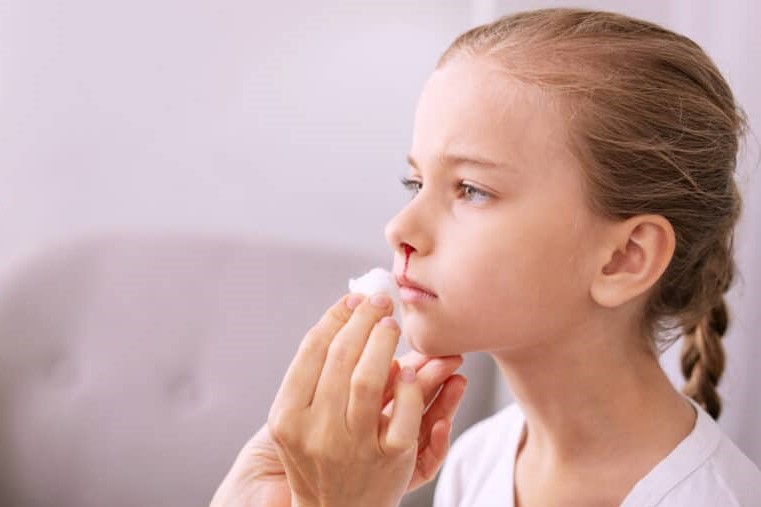
What are the causes of nosebleeds in adults and children?
A nosebleed or rhinorrhage, i.e. the discharge of blood from the nose, is a frequent occurrence at all ages. The blood that is lost on these occasions always seems to be very copious, so that people are often alarmed to the point of going to the emergency room
In reality, in the vast majority of cases, the amount of blood is minimal and the causes local and of no concern.
Nosebleeds are usually due to
- to minor trauma, such as that caused by blowing one’s nose too vigorously;
- the habit of sticking one’s fingers up one’s nose, common in children;
- infections, such as colds or rhinosinusitis, (favoured in summer by temperature changes due to often excessive use of air conditioning.
However, if the problem tends to recur with some frequency, especially in adults, it may be an indication of more serious reasons and problems.
Epistaxis, causes in children and adults
In children, the most common causes of nosebleeds are:
- trauma from picking their nose;
- dryness of the nasal mucosa.
In adults, on the other hand, in addition to these factors there are others, both local and general: nosebleeds are not uncommon, for example, in people who use nasal medications such as corticosteroids and antihistamines for therapeutic purposes.
In this case, the incidence is lower in individuals who direct the jet laterally to minimise the effect of these medicines on the septum.
Very profuse nosebleeds can also occur following trauma to the nasal bones or septum or septal perforations: idiopathic or acquired, as when, for example, nasal vasoconstrictors or toxic substances such as cocaine are abused.
And again in association with viral or bacterial rhinosinusitis and tumours.
In addition to these local factors, recurrent nosebleeds may also be linked to general conditions, such as:
- coagulopathies (disease of blood clotting processes);
- use of anticoagulants for cardiovascular disease;
- tumours of haematological origin.
Arterial hypertension can also cause nosebleeds during hypertensive crises with subsequent rupture of a blood vessel in the nose.
Rhinorrhagia, what to do when nosebleeds occur
The first rule for dealing with an emergency is to avoid bending your head back.
Although it is the most instinctive gesture, it can be dangerous because it encourages the inhalation of blood into the airways.
What else can be done?
Given that most anterior bleedings are self-limiting, i.e. they wear off on their own, and do not require medical treatment, what anyone can do are so-called self-tamponade manoeuvres, which can be summarised as follows
- standing (or sitting) with head erect or rather flexed forward;
- blow your nose firmly, even if blood comes out;
- immediately after blowing press the nose between two fingers, firmly, closing the nostrils;
- remain in this position for a few minutes (3 to 5 clock!);
- try in every way to calm down;
- put some nasal emollient-healing ointment on the reopening of the nose;
- repeat the same procedure step by step if the problem is not resolved the first time.
Do grandma’s remedies work?
The various ‘grandmother’s’ expedients, such as putting the wrists under water, wetting the nape of the neck or forehead and so on, follow a logic of ancient wisdom, but are too ‘slow’ in achieving their purpose.
After self-tamping, however, it may be helpful to place ice in a small plastic bag over the nose.
The introduction of ‘haemostatic cotton’, which is sometimes optimal in resolving nosebleeds, but then difficult to remove, is inadvisable, as is that of any absorbent material (cotton, gauze, paper towels, etc.).
When is it necessary to go to A&E for epistaxis?
If the nosebleed does not stop, or if it is recurrent, it is a good idea to go to the emergency room.
Further treatment may be required.
These include an anterior nasal tamponade, carried out by the ENT (or emergency room doctor).
In general, a swab with non-degradable material is used, usually a hydroxylated polyvinyl acetate sponge that swells when wet.
The swab is removed after 48-72 hours.
Insertion and removal may be uncomfortable or painful, especially if the nasal septum is deviated.
In addition to these swabs, a variety of absorbable or biodegradable materials are available, which do not require removal and may be useful for patients with milder nosebleeds.
In the case of significant posterior epistaxis, i.e. with blood also flowing towards the pharynx (in a seated and corrected position), nasal tamponade becomes deeper, more complex and sometimes requires several materials (posterior nasal tamponade).
As well as, in more severe cases, a bleeding control in the operating theatre, under anaesthesia.
After removal of the nasal swab, it is advisable to use local ointments or antibiotic creams for emollient, healing and protective purposes.
Finally, in some cases, cautery, i.e. the ‘burning’ of the bleeding capillary through bipolar electrocoagulation of the affected blood vessel with dedicated equipment, can be used as an alternative to swabbing.
Read Also:
Emergency Live Even More…Live: Download The New Free App Of Your Newspaper For IOS And Android
What Should Be In A Paediatric First Aid Kit
Ukraine Under Attack, Ministry Of Health Advises Citizens About First Aid For Thermal Burn
Electric Shock First Aid And Treatment
10 Basic First Aid Procedures: Getting Someone Through A Medical Crisis



